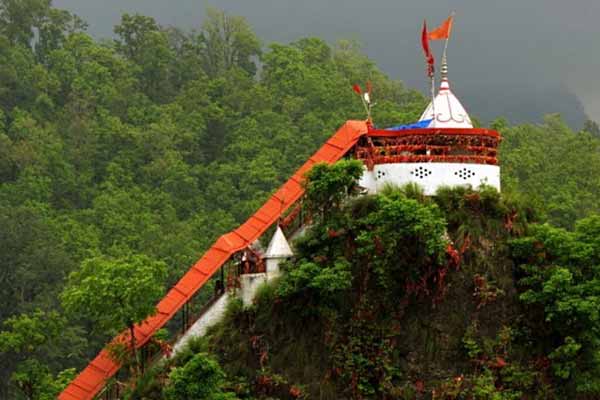Garjiya Devi Temple is a revered Hindu shrine located near Jim Corbett National Park in Uttarakhand, India. Situated on the banks of the Kosi River, the temple is dedicated to Goddess Parvati, also known as Garjiya Devi or Girija Devi. This ancient temple holds significant religious importance among the locals and attracts a large number of devotees and tourists throughout the year.
The temple is perched on a large rock amidst the picturesque surroundings of dense forests and flowing river waters. Devotees visit the temple to seek blessings for prosperity, protection, and fulfillment of their wishes. The serene ambiance of the temple, coupled with the soothing sounds of the river, creates a tranquil atmosphere ideal for meditation and spiritual reflection.
Apart from its religious significance, Garjiya Devi Temple offers breathtaking views of the surrounding natural landscape, making it a popular spot for photography enthusiasts and nature lovers. The temple is also adorned with intricate architectural details, reflecting the rich cultural heritage of the region.
Visiting Garjiya Devi Temple provides not only a spiritual experience but also an opportunity to immerse oneself in the beauty of nature and the cultural essence of Uttarakhand.

History of Garjiya Devi Temple
The history of Garjiya Devi Temple is steeped in legend and folklore, tracing back centuries in the annals of Hindu mythology. While the precise historical origins may not be well-documented, the temple holds significant religious and cultural importance in the region. Here’s an overview of the history and legend associated with Garjiya Devi Temple:
Legend has it that Garjiya Devi Temple is dedicated to Goddess Parvati, who is also known as Girija Devi or Garjiya Devi. According to local folklore, the temple’s origins date back to the ancient times when a huge rock, believed to be the abode of Goddess Garjiya, was found on the banks of the Kosi River.
One popular legend associated with the temple revolves around the devotion of a local deity named Garjia, who was a manifestation of Goddess Parvati. It is said that Garjia, in her human form, meditated and performed penance on the rock where the temple now stands. Impressed by her devotion, Lord Shiva granted her the status of a goddess, and the temple was subsequently built in her honor.
Another legend recounts the story of a sage named Bhairav, who worshipped Goddess Garjiya with utmost devotion. Pleased with his prayers, the goddess appeared before him and blessed him with divine powers. To commemorate this divine encounter, Bhairav constructed the temple atop the rock where Goddess Garjiya had manifested.
Over the centuries, Garjiya Devi Temple has been renovated and rebuilt several times, evolving into the magnificent structure that stands today. Despite its ancient origins, the temple continues to attract devotees from far and wide, who visit to seek the blessings of Goddess Garjiya for prosperity, protection, and fulfillment of their wishes.
The temple’s history is intertwined with the cultural fabric of Uttarakhand, serving as a sacred pilgrimage site and a symbol of faith for generations of devotees. Its serene location amidst the natural beauty of the Kosi River and the surrounding forests adds to its allure, making it not just a religious destination but also a tranquil retreat for spiritual seekers and nature enthusiasts alike.
Best Time to Visit Garjiya Temple
The best time to visit Garjiya Devi Temple is during the months of October to March, which coincides with the autumn, winter, and early spring seasons in Uttarakhand. During this time, the weather is pleasant and conducive for sightseeing and outdoor activities. The temperatures are mild, ranging from comfortable to cool, making it ideal for exploring the temple premises and enjoying the scenic beauty of the surrounding area.
Additionally, visiting during these months allows you to avoid the peak summer season, when temperatures can soar and the weather can be hot and humid. Similarly, it’s best to avoid the monsoon season, typically from July to September, as heavy rainfall can make the journey to the temple difficult and the surroundings may be prone to landslides and other hazards.
Overall, visiting Garjiya Devi Temple during the cooler months of the year ensures a more enjoyable and comfortable experience, allowing you to fully appreciate the spiritual ambiance and natural beauty of this revered Hindu shrine.
How To Reach Garjiya Temple
Garjiya Devi Temple is located near Jim Corbett National Park in the Nainital district of Uttarakhand, India. Here’s how you can reach the temple:
By Air: The nearest airport to Garjiya Temple is Pantnagar Airport, located approximately 90 kilometers away. From the airport, you can hire a taxi or take a bus to reach the temple. Pantnagar Airport is well-connected to major cities like Delhi.
By Train: The nearest railway station to Garjiya Temple is Ramnagar Railway Station, situated around 15 kilometers away. Ramnagar is well-connected to cities like Delhi, Moradabad, and Bareilly. From the railway station, you can hire a taxi or take a local bus to reach the temple.
By Road: Garjiya Temple is easily accessible by road. You can drive to the temple from nearby cities like Nainital, Haldwani, or Ramnagar. The temple is located just off the National Highway 309 (NH309), which connects Ramnagar to Nainital. Regular bus services operate from major cities in Uttarakhand to Ramnagar, from where you can hire a taxi or take a local bus to reach the temple.
Local Transport: Once you reach the vicinity of Garjiya Temple, you can easily find local taxis, auto-rickshaws, or cycle-rickshaws to reach the temple premises. The temple is situated on the banks of the Kosi River, and a short bridge connects it to the main road.
Regardless of the mode of transportation you choose, reaching Garjiya Devi Temple is relatively convenient, and the journey offers scenic views of the surrounding Himalayan landscapes.
